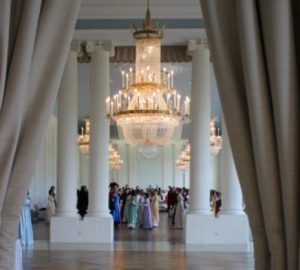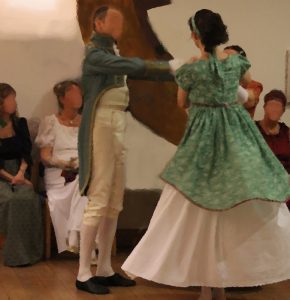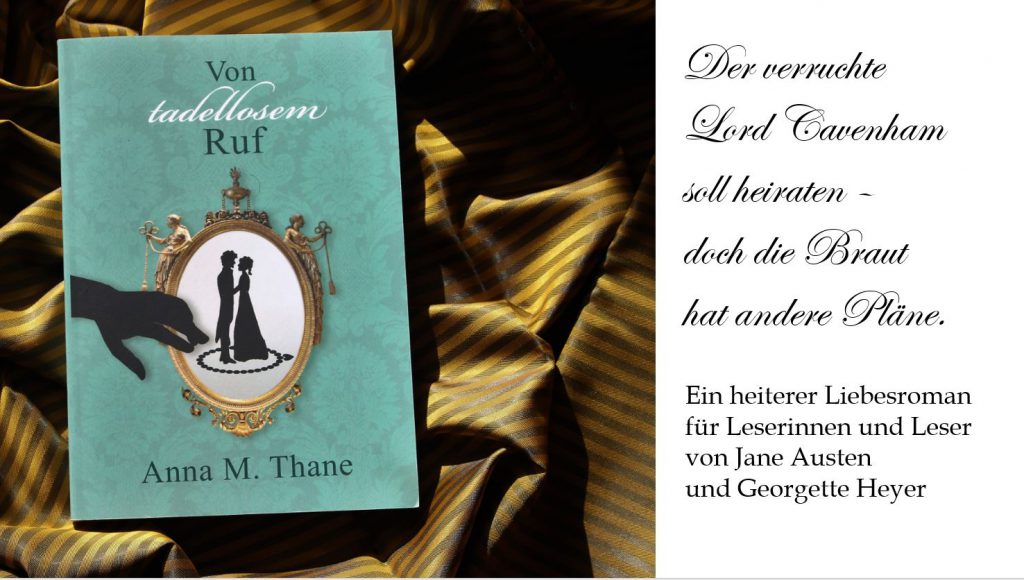 May I have the pleasure of this Waltz? It is the most controversial dance of the Regency Period. That the Waltz was considered scandalous certainly isn’t new to you. But there were more reasons than too much intimacy between the dance partners that made people turn up their noses at the Waltz. Among the despisers was e.g. Lord Byron who can hardly be counted among the moralisers of the age. So what was wrong with the Waltz?
May I have the pleasure of this Waltz? It is the most controversial dance of the Regency Period. That the Waltz was considered scandalous certainly isn’t new to you. But there were more reasons than too much intimacy between the dance partners that made people turn up their noses at the Waltz. Among the despisers was e.g. Lord Byron who can hardly be counted among the moralisers of the age. So what was wrong with the Waltz?
The Waltz – originally a rural dance – became fashionable in Vienna around the 1780ies, and quickly conquered ballrooms all over the continent. It reached England in 1791. Its rise to fame was still to come. Soldiers were dancing the waltz before it became acceptable to High Society. Bringing it into fashion among the ton is usually credited to Philipp Baron de Neumann, a young diplomat, and Dorothea Lieven, wife of the Russian ambassador. From about 1812, the waltz was the most fashionable dance in the ballrooms. Yet, it was highly controversial.
Shocking intimacy of the dancers
There certainly was a new quality to the dance which startled the old-fashioned: So far, dancing – e.g. Country Dances – had been an activity for a group of dancers. The Waltz, however, was a couple dance. Moreover, there was physical contact involved. A lot of physical contact.
While country dances certainly know eye contact as well as some body contact, this is fleeting and moves from one dance partner of the group to the other. Body contact is limited to the hands. But when a couple waltzes, eye contact is continuous and the body contact includes, e.g. the waist and the shoulder. Postures of the dance, such as one arm across the front of the partner’s body and the other hands forming an arch above the body, can be rather sensuous, especially if you rotate slowly, and have unflinching eye contact. Give the historical Waltz a try and find out if it doesn’t give you weaker knees than the contemporary version of the Waltz.
Watch a couple dance a Waltz as it was done in 1816 here: https://www.youtube.com/watch?v=MB–uboHc9I (Wilson’s Waltz Suite (1816), by the Commonwealth Vintage Dancers)
Dangerous social connotation
 Intimacy was not the only dangerous aspect of this dance. There also was a social aspect to it that some people found worrying. The Waltz was a ‘modern’ dance. It replaced the Minuet. The Minuet was associated with the social order of the ancien régime, and the strict separation of the classes before the French Revolution. In a Country Dance, the dance set would be arranged in order of social rank. In the Waltz, the couple was secluded from the rest of the company and danced comparatively individually. Thus, it was associated with Romanticism and the rise of the bourgeoisie. The Waltz could be a symbol of social disorder and the ‘dangerous’ concept of democracy.
Intimacy was not the only dangerous aspect of this dance. There also was a social aspect to it that some people found worrying. The Waltz was a ‘modern’ dance. It replaced the Minuet. The Minuet was associated with the social order of the ancien régime, and the strict separation of the classes before the French Revolution. In a Country Dance, the dance set would be arranged in order of social rank. In the Waltz, the couple was secluded from the rest of the company and danced comparatively individually. Thus, it was associated with Romanticism and the rise of the bourgeoisie. The Waltz could be a symbol of social disorder and the ‘dangerous’ concept of democracy.
Anti-Hanoverian concepts
Additionally, the Waltz was disliked by some for its political connotations. The Waltz was believed to be German. Thus, it was easily associated with the House of Hanover, as the British King George III was concurrently Duke and prince-elector of Brunswick-Lüneburg (“Hanover”). Both the King and the Prince Regent were believed to have a degenerating effect upon English life and politics. In times of censorship, criticising the Waltz was a relatively safe way to criticize the King, and the Prince of Wales. Lord Byron’s poem “Waltz: An Apostrophic Hymn” (published in 1813) is often interpreted as ‘Regent baiting’ and conveying Anti-Hanoverian sentiments.
Conclusion: One dance, many dangers
Disliking the Waltz could have many reasons. Too much intimacy between the dance partner might be among them, but let’s keep in mind that the Waltz was also associated with social and political concepts. If parents did not allow their daughters to waltz, they might want to point out their loyalty to an intact hierarchy as known before the French Revolution. The Waltz could also be associated with the ton, happily dancing the Waltz under the leadership of the Prince of Wales. High Society came increasingly under pressure for their lavish lifestyle in times of crises and war. Despisers of The Waltz thus might express their disgust about the exuberant lifestyle of their Prince Regent and the social elite. They also might tend to anti-Hanoverian or anti-royal sentiments.
Related articles
- A Jane Austen Ball in Pictures
- Anna and the Mystery of the Triple Minor (part 1)
- Anna and the Mystery of the Triple Minor (part 2) – Free Music Download of “Lady Caroline Lee’s Waltz
Sources
- William Childers: Byron’s “Waltz”: The Germans and Their Georgesm, Keats-Shelley Journal, Vol. 18 (1969), pp. 81-95.
- Walter Nelson, “The Shocking Waltz”.
- Cheryl A. Wilson, “The Arrival of the Waltz in England, 1812”.
- Peter Cochran, “Waltz“.
- Byron, George Gordon. “Waltz: An Apostrophic Hymn.” The Complete Poetical Works. Vol. 3. Ed. Jerome J. McGann. New York: Oxford UP, 1981. 22-31. Print.
- Chuck H.: “The Indecent Foreign Dance: The Waltz Arrives in England”.
Article by Anna M. Thane, author of the novel
“Von tadellosem Ruf” (http://amzn.to/2TXvrez)

